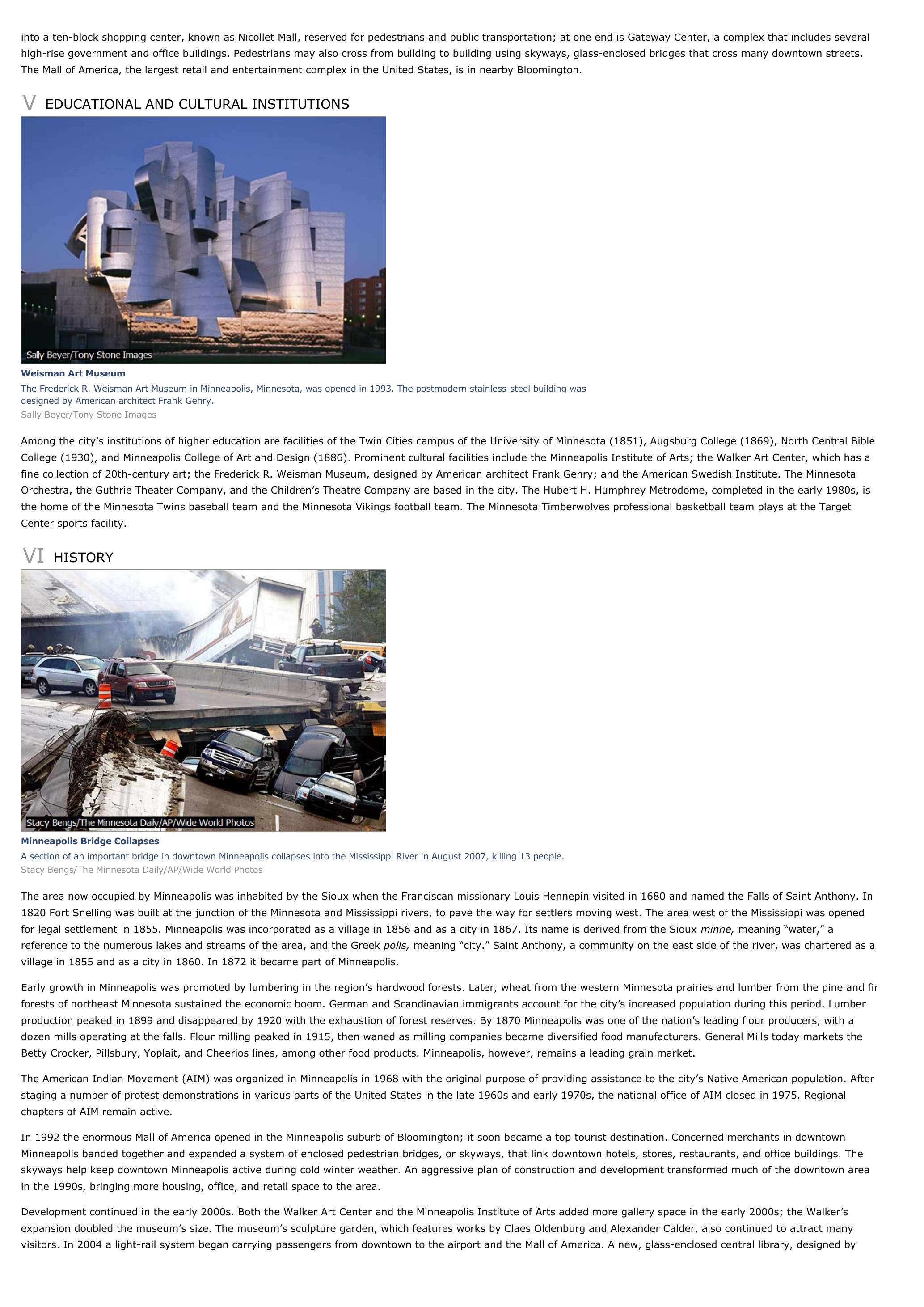Minneapolis - geography.
Publié le 27/05/2013
Extrait du document
«
into a ten-block shopping center, known as Nicollet Mall, reserved for pedestrians and public transportation; at one end is Gateway Center, a complex that includes severalhigh-rise government and office buildings.
Pedestrians may also cross from building to building using skyways, glass-enclosed bridges that cross many downtown streets.The Mall of America, the largest retail and entertainment complex in the United States, is in nearby Bloomington.
V EDUCATIONAL AND CULTURAL INSTITUTIONS
Weisman Art MuseumThe Frederick R.
Weisman Art Museum in Minneapolis, Minnesota, was opened in 1993.
The postmodern stainless-steel building wasdesigned by American architect Frank Gehry.Sally Beyer/Tony Stone Images
Among the city’s institutions of higher education are facilities of the Twin Cities campus of the University of Minnesota (1851), Augsburg College (1869), North Central BibleCollege (1930), and Minneapolis College of Art and Design (1886).
Prominent cultural facilities include the Minneapolis Institute of Arts; the Walker Art Center, which has afine collection of 20th-century art; the Frederick R.
Weisman Museum, designed by American architect Frank Gehry; and the American Swedish Institute.
The MinnesotaOrchestra, the Guthrie Theater Company, and the Children’s Theatre Company are based in the city.
The Hubert H.
Humphrey Metrodome, completed in the early 1980s, isthe home of the Minnesota Twins baseball team and the Minnesota Vikings football team.
The Minnesota Timberwolves professional basketball team plays at the TargetCenter sports facility.
VI HISTORY
Minneapolis Bridge CollapsesA section of an important bridge in downtown Minneapolis collapses into the Mississippi River in August 2007, killing 13 people.Stacy Bengs/The Minnesota Daily/AP/Wide World Photos
The area now occupied by Minneapolis was inhabited by the Sioux when the Franciscan missionary Louis Hennepin visited in 1680 and named the Falls of Saint Anthony.
In1820 Fort Snelling was built at the junction of the Minnesota and Mississippi rivers, to pave the way for settlers moving west.
The area west of the Mississippi was openedfor legal settlement in 1855.
Minneapolis was incorporated as a village in 1856 and as a city in 1867.
Its name is derived from the Sioux minne, meaning “water,” a reference to the numerous lakes and streams of the area, and the Greek polis, meaning “city.” Saint Anthony, a community on the east side of the river, was chartered as a village in 1855 and as a city in 1860.
In 1872 it became part of Minneapolis.
Early growth in Minneapolis was promoted by lumbering in the region’s hardwood forests.
Later, wheat from the western Minnesota prairies and lumber from the pine and firforests of northeast Minnesota sustained the economic boom.
German and Scandinavian immigrants account for the city’s increased population during this period.
Lumberproduction peaked in 1899 and disappeared by 1920 with the exhaustion of forest reserves.
By 1870 Minneapolis was one of the nation’s leading flour producers, with adozen mills operating at the falls.
Flour milling peaked in 1915, then waned as milling companies became diversified food manufacturers.
General Mills today markets theBetty Crocker, Pillsbury, Yoplait, and Cheerios lines, among other food products.
Minneapolis, however, remains a leading grain market.
The American Indian Movement (AIM) was organized in Minneapolis in 1968 with the original purpose of providing assistance to the city’s Native American population.
Afterstaging a number of protest demonstrations in various parts of the United States in the late 1960s and early 1970s, the national office of AIM closed in 1975.
Regionalchapters of AIM remain active.
In 1992 the enormous Mall of America opened in the Minneapolis suburb of Bloomington; it soon became a top tourist destination.
Concerned merchants in downtownMinneapolis banded together and expanded a system of enclosed pedestrian bridges, or skyways, that link downtown hotels, stores, restaurants, and office buildings.
Theskyways help keep downtown Minneapolis active during cold winter weather.
An aggressive plan of construction and development transformed much of the downtown areain the 1990s, bringing more housing, office, and retail space to the area.
Development continued in the early 2000s.
Both the Walker Art Center and the Minneapolis Institute of Arts added more gallery space in the early 2000s; the Walker’sexpansion doubled the museum’s size.
The museum’s sculpture garden, which features works by Claes Oldenburg and Alexander Calder, also continued to attract manyvisitors.
In 2004 a light-rail system began carrying passengers from downtown to the airport and the Mall of America.
A new, glass-enclosed central library, designed by.
»
↓↓↓ APERÇU DU DOCUMENT ↓↓↓
Liens utiles
- Minneapolis - geography.
- White Minor, 1908-1976, né à Minneapolis (Minnesota), photographe américain.
- Prince (Prince Rogers Nelson, dit), né en 1958 à Minneapolis, musicien américain.
- Minneapolis.
- Gilliam Terry , né en 1940 à Minneapolis (Minnesota), cinéaste américain.

































